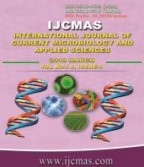


 National Academy of Agricultural Sciences (NAAS)
National Academy of Agricultural Sciences (NAAS)

|
PRINT ISSN : 2319-7692
Online ISSN : 2319-7706 Issues : 12 per year Publisher : Excellent Publishers Email : editorijcmas@gmail.com / submit@ijcmas.com Editor-in-chief: Dr.M.Prakash Index Copernicus ICV 2018: 95.39 NAAS RATING 2020: 5.38 |
In the present investigation dry and homogeneous seeds of two varieties of sesame were irradiated with different doses of gamma rays viz. 250, 300, 350 and 400 Gy. The effect of mutagenesis or radio sensitivity of gamma rays on different biological parameters like germination (%), pollen fertility (%), shoot length, root length, plant survival are being studied in M1 generation. It has been found that germination (%) and plant survival (%) and shoot length decreased progressively with increasing doses of gamma rays, whereas in case of pollen fertility (%), shoot length, root length, there was gradual decrease with increase in doses in both the varieties of sesame. In the cases of biological parameters, where doses higher than 400 Gy were required to obtain 50% reduction, ID30, ID25, ID15(Inhibitory dose) were calculated. It was clear that for germination (%) and plant survival, Tillotoma was more radiosensitive than Rama, whereas for pollen fertility (%), shoot length, root length, plant survival, the cultivar Rama was more radiosensitive than Tillotoma.
 |
 |
 |
 |
 |